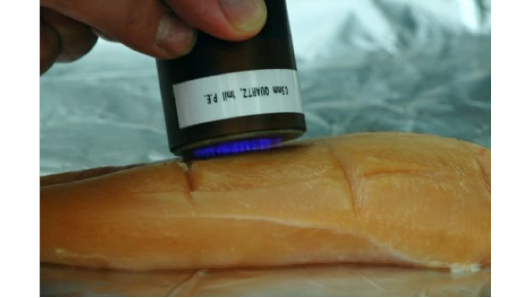Cold plasma used to kill bacteria on raw chicken
13:24 February 7, 2012

A plasma torch eliminates bacteria from raw chicken
Judging by the number of folks who fall prey to food-borne illness each year, food safety is serious business, especially when you consider that pathogens such as Campylobacter and Salmonella contaminate over 70 percent of the raw chicken meat tested. Now, recent research from a food safety team at Pennsylvania's Drexel University offers proof-of-concept for what may one day be a common approach to preventing food-borne illness from raw poultry and meat products - the use of high-energy, low temperature plasma to eliminate unwanted bacteria while leaving the food basically unchanged.
The Drexel team, led by assistant professor Jennifer Quinlan and grad student Brian Dirks, applied a plasma torch to uncooked chicken in an effort to reduce its pathogen load. After treating the poultry for various times ranging up to 180 seconds, the plasma entirely eliminated or substantially reduced low levels of bacteria from both skinless chicken breasts and chicken skin itself. Even bacteria levels on highly contaminated samples were significantly lowered.
"If you could reduce contamination on the raw chicken, then you wouldn't have it in the kitchen," Quinlan explained. Keeping pathogens from entering the consumer's home also reduces the likelihood of infection from cross-contamination of other foods, still a major problem in food safety today.
Schematic of plasma torch in operation
We reported on cold plasma's anti-bacterial properties some time ago, but the technology still has a long way to go before it becomes cost-effective enough to be deployed on factory farm production lines. As Dirks points out, a major part of plasma's appeal "is that it is non-thermal, so there is no heat to cook or alter the way the food looks." Given the amount of safety this new technique can provide, it's likely only a matter of time before we'll see plasma teaming up with conventional methods to keep bacterial contamination in check. Indeed, one day, chicken tartare may no longer be just the stuff of dreams.
The team's findings are detailed in the paper Treatment of Raw Poultry with Nonthermal Dielectric Barrier Discharge Plasma To Reduce Campylobacter jejuni and Salmonella enterica which was recently published in the Journal of Food Protection.
Source: Drexel University
Copyright © gizmag 2003 - 2012 To subscribe or visit go to: http://www.gizmag.com
